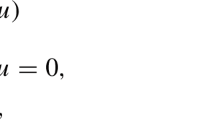Abstract
We analyze the method of sequential quadratic programming for equality constrained minimization problems in Hilbert spaces of functions, and for the discrete approximations of such problems in the context of an elliptic parameter identification problem. We show how the discretization can be constructed so as to preserve the convergence behavior of the iterates for the infinite dimensional problem in the finite dimensional approximations. We use the structure of the parameter identification problem to reduce the size of the linear system for the SQP step and verify nondegeneracy of the constraints.
Similar content being viewed by others
References
E.L. Allgower, K. Böhmer, F.A. Potra and W.C. Rheinboldt, “A mesh-independence principle for operator equations and their discretizations,”SIAM Journal on Numerical Analysis 23 (1986) 160–169.
P.T. Boggs and J.W. Tolle, “A family of descent functions for constrained optimization,”SIAM Journal on Numerical Analysis 21 (1984) 1146–1161.
F. Colonius and K. Kunisch, “Output least squares stability for parameter estimation in two point boundary value problems,”Journal für die Reine und Angewandte Mathematik 270 (1986) 1–29.
R. Fletcher,Practical Methods of Optimization (Wiley, New York, 1987).
S.-P. Han, “A globally convergent method for nonlinear programming,”Journal of Optimization Theory and Applications 22 (1977) 297–309.
K. Ito and K. Kunisch, “The augmented Lagrangian method for equality and inequality constrained problems in Hilbert spaces, to appear in:SIAM Journal on Control and Optimization.
A.D. Ioffe, “Necessary and sufficient conditions for a local minimum. 1: A reduction theorem and first order conditions,”SIAM Journal on Control and Optimization 17 (1979) 245–250.
A.D. Ioffe, “Necessary and sufficient conditions for a local minimum. 2: Conditions of Levitin—Miljutin—Osmolovskii type,”SIAM Journal on Control and Optimization 17 (1979) 251–265.
A.D. Ioffe, “Necessary and sufficient conditions for a local minimum. 3: Second order conditions and augmented duality,”SIAM Journal on Control and Optimization 17 (1979) 266–288.
K. Ito and K. Kunisch, “The augmented Lagrangian method for parameter estimation in elliptic systems,” Technical Report #87-37, Lefschetz Center for Dynamical Systems and Center for Control Sciences (Lefschetz, 1987).
L.V. Kantorovich and G.P. Akilov,Functional Analysis (Pergamon, New York, 1982), 2nd ed.).
C. Kravaris and J. Seinfeld, “Identification of parameters in distributed parameter systems by regularization,”SIAM Journal on Control and Optimization 23 (1985) 217–241.
C. Kravaris and J. Sinfeld, “Identification of spatially varying parameters in distributed parameter systems by discrete regularization,”Journal of Mathematical Analysis and Applications 119 (1986) 128–152.
M. Kroller and K. Kunisch, “A numerical study of an augmented Lagrangian method for the estimation of parameters in a two point boundary value problem,” Technische Universität Graz Technical Report #87, Institute für Mathematik, (Graz, 1987).
K. Kunisch and L. White, “Regularity properties in parameter estimation of diffusion coefficients in one dimensional elliptic boundary value problems,”Applicable Analysis 21 (1986) 71–87.
M.J.D. Powell and Y. Yuan, “A recursive quadratic programming algorithm that uses differentiable penalty functions,”Mathematical Programming 35 (1986) 265–278.
R.T. Rockafellar, “Augmented Lagrane multiplier functions and duality in nonlinear programming,”SIAM Journal on Control 12 (1974) 268–285.
R. Temam,Navier—Stokes Equations, Theory and Numerical Analysis (North-Holland, New York, 1985).
Author information
Authors and Affiliations
Additional information
Supported by National Science Foundation grants #DMS-8601139 and #DMS-8900410, and Air Force Office of Scientific Research grants #AFOSR-ISSA-860074, #AFOSR-ISSA-890044 and #AFOSR-89-0124.
Supported by National Science Foundation grants #DMS-8619903, #DMS-8900984 and #ASC-8714009, and Air Force Office of Scientific Research grants #AFOSR-ISSA-870092 and #AFOSR-89-0124.
Rights and permissions
About this article
Cite this article
Kelley, C.T., Wright, S.J. Sequential quadratic programming for certain parameter identification problems. Mathematical Programming 51, 281–305 (1991). https://doi.org/10.1007/BF01586941
Received:
Revised:
Issue Date:
DOI: https://doi.org/10.1007/BF01586941



